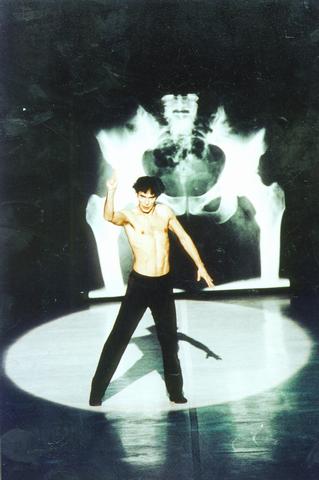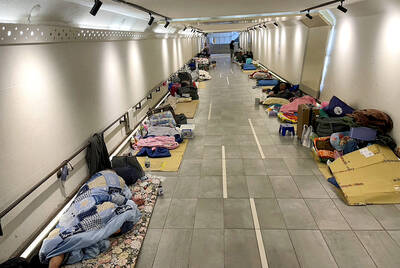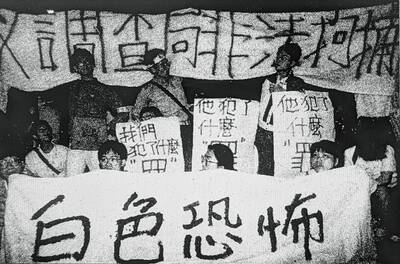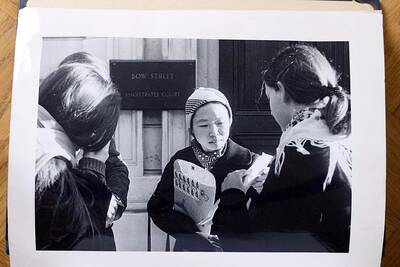The Great Pretender, The Show Must Go On, I Want To Break Free -- the titles of some of Queen's hits have an eerie resonance with the lives of the two men whose careers are celebrated in French choreographer Maurice Bejart's rock ballet Le Presbytere N'a Rien Perdu De Son Charme, Ni Le Jardin De Son Eclat, or as it is more commonly known, Ballet for Life. The Bejart Ballet Lausanne will be performing the ballet for four nights at the National Theater in Taipei, beginning tonight.
The 1997 ballet is a tribute to Bejart's great muse and the principal dancer of his company for many years, Argentinean Jorge Donn, and to the rock star Freddie Mercury, lead singer and frontman of Queen, both of whom died of AIDS at age 45.
An unlikely combination of subjects for anyone but Bejart, who has often tackled autobiographical themes in his choreography, such as his ballets on the lives of Wolfgang Amadeus Mozart, Charlie Chaplin and the Empress Elizabeth of Austria.

PHOTO COURTESY OF BEJART BALLET LAUSANNE
Two other reoccurring themes in his work are homages to unconventional people and artists who died young.
In his notes on Ballet for Life, Bejart says the idea for the ballet was sparked by his discovery that the cover of Queen's last album with Mercury was a photograph of the mountains and Lake Geneva that looked as if it had been taken right in front of Bejart's own chalet in Montreux, where he had retreated to after Donn's death in 1992.
It turned out that Mercury had spent his last months in a chalet in the same area. Bejart then read everything he could find about Mercury and listened to Queen's albums and watched their videos.
The result is a theatrical extravaganza that runs just over 100 minutes, without interruption; a series of 20 vignettes using 17 Queen songs interspersed with music from Mozart and a film celebrating Donn's life, including footage of him in one of his great roles, Bejart's Nijinsky, Clown of God.
Donn was an amazing dancer and was often compared with the Russian greats Rudolf Nureyev, who also died of AIDS, and Mikhail Baryshnikov, even though their repertoires were very different from his.
One unanticipated link with the ballet's theme of men cut down in the prime of their lives is that its costumes were designed by the Italian designer, Gianni Versace, a frequent collaborator of Bejart's, who was murdered in 1997.
Dancing the role of Donn is the man who stepped into his shoes as Bejart's principal dancer and deputy director of the company, Frenchman Gil Roman. His dark Gallic looks are a photographic negative to Donn's, whose blonde mane was almost a trademark.
They are also a stark contrast to his compatriot Julien Favreau, who, despite his blonde locks, dances the role of Freddie Mercury, platform boots, fishnet catsuits and all.
A deliberate juxtaposition by Bejart? Perhaps, but as Roman said in a press conference on Tuesday, Bejart usually starts with a dancer and his or her talents and choreographs from there, rather than trying to pick dancers who can do the steps to a dance that is already completed.
Roman noted that Bejart is also famous for retailoring pieces when a dancer leaves the company to fit the replacement. While Roman originated the role of Donn, Favreau took on the role of Mercury after the original dancer left.
Ballet for Life can be interpreted as a protest against the cruelties of life, but it is also a celebration of the joys of life and of youth and hope.
"The ballet is not all sadness," Roman said. "It is bursting with joy and energy."
Bejart's ballets often polarize opinion, and not just for their subject matter.
Many balletomanes find them too theatrical -- no surprise given Bejart's experience as a director of plays and operas -- and lacking in sufficient dance. Other critics have called them chaotic. Europeans and Japanese love them, while the response in Britain and the US has been more lukewarm. The one thing everyone seems to be able to agree on is that they are rarely boring.
Dancers, however, adore them. Company member Roger Cunningham, an American who spent 10 years with the Boston Ballet, said one of the reasons he wanted to join the the Bejart Ballet Lausanne five years ago was the chance to do more contemporary pieces instead of the classics that US companies focus on.
Cunningham said the Bejart gives dancers the chance to explore their abilities -- and to stretch them.
Bejart has been quoted as saying: "My ballets are first encounters ... with a piece of music, with life, death, love ... with people whose past and work are embodied in me, just like the dancer -- which I no longer am -- who each time embodies characters that go beyond him. Imagination, violence, humor, love. Everything is there."
The Bejart Ballet Lausanne is the third of Bejart's companies, founded in 1987 in the wake of the Ballet de l'Etoile in Paris and the Ballet du XXe Siecle in Brussels.
The full company, 30 dancers, is making its first appearance in Taipei, the fourth Asian city on this tour, after Seoul, Beijing and Shanghai.
Among the principal dancers featured in Ballet for Life are dancer and choreographer Kathryn Bradney, Elizabet Ros and Cunningham.
For those who don't speak French, Le Presbytere N'a Rien Perdu De Son Charme, Ni Le Jardin De Son Eclat translates as The Priest House Has Not Lost Its Charm, Neither Has the Garden Has Lost Its Glamour.
What does it mean in relation to the ballet? Absolutely nothing.
It is a phase taken from a book written in the 1920s by Gaston Leroux, a secret code used by one of the characters.
In his notes on the ballet, Bejart says that the phrase became a cult hit among surrealists in the 1920s and he just happens to like it and wanted to use it because "it gives nothing away and has a nice rhythm when you say it."
That's classic Bejart: throwaway phasing combined with spectacular gestures and doing things just because he likes them even if no one understands.
Performance Notes
What: Ballet for Life
Where and When: National Theater, today through Sunday at 7:30pm.
Tickets: NT$1,000 to NT$4,000. Tickets are available through major ticketing outlets or at the door.

From the last quarter of 2001, research shows that real housing prices nearly tripled (before a 2012 law to enforce housing price registration, researchers tracked a few large real estate firms to estimate housing price behavior). Incomes have not kept pace, though this has not yet led to defaults. Instead, an increasing chunk of household income goes to mortgage payments. This suggests that even if incomes grow, the mortgage squeeze will still make voters feel like their paychecks won’t stretch to cover expenses. The housing price rises in the last two decades are now driving higher rents. The rental market

July 21 to July 27 If the “Taiwan Independence Association” (TIA) incident had happened four years earlier, it probably wouldn’t have caused much of an uproar. But the arrest of four young suspected independence activists in the early hours of May 9, 1991, sparked outrage, with many denouncing it as a return to the White Terror — a time when anyone could be detained for suspected seditious activity. Not only had martial law been lifted in 1987, just days earlier on May 1, the government had abolished the Temporary Provisions Effective During the Period of National Mobilization for Suppression of the Communist

Hualien lawmaker Fu Kun-chi (傅?萁) is the prime target of the recall campaigns. They want to bring him and everything he represents crashing down. This is an existential test for Fu and a critical symbolic test for the campaigners. It is also a crucial test for both the Chinese Nationalist Party (KMT) and a personal one for party Chairman Eric Chu (朱立倫). Why is Fu such a lightning rod? LOCAL LORD At the dawn of the 2020s, Fu, running as an independent candidate, beat incumbent Democratic Progressive Party (DPP) lawmaker Hsiao Bi-khim (蕭美琴) and a KMT candidate to return to the legislature representing

Fifty-five years ago, a .25-caliber Beretta fired in the revolving door of New York’s Plaza Hotel set Taiwan on an unexpected path to democracy. As Chinese military incursions intensify today, a new documentary, When the Spring Rain Falls (春雨424), revisits that 1970 assassination attempt on then-vice premier Chiang Ching-kuo (蔣經國). Director Sylvia Feng (馮賢賢) raises the question Taiwan faces under existential threat: “How do we safeguard our fragile democracy and precious freedom?” ASSASSINATION After its retreat to Taiwan in 1949, the Chinese Nationalist Party (KMT) regime under Chiang Kai-shek (蔣介石) imposed a ruthless military rule, crushing democratic aspirations and kidnapping dissidents from